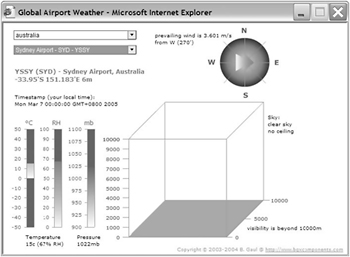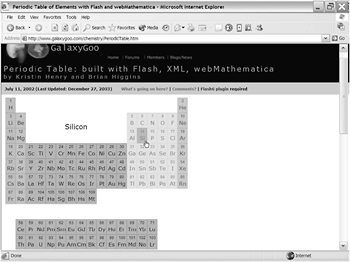Visualizing Complex Information
| | ||
| | ||
| | ||
Another strength of Flash is its ability to provide a visual representation of complex information. If you search for Flash maps in your favorite search engine, youll find many commercial products that use Flash to display location maps. Some of these offer XML support for plotting specific points.
In another example, Bernhard Gaul has used Flash as an interface for a global airport weather web service. The information comes from the Cape Science GlobalWeather web service in XML format; Figure 1-3 shows a screenshot.

Figure 1-3: Global airport weather information displayed in a Flash movie with content from a web service
Strong visual elements show information such as wind direction, temperature, and pressure. Its much easier to get a sense of the weather from this Flash movie compared with reading a list of figures. You can find out more at www11.brinkster.com/bgx/ webservices /weather.html.
You can also find this at www11.brinkster.com/bgx/webservices/weather.html. Open the website in your favorite browser and click the View the Flash Visualization link.
Another example of visualizing information is in the periodic table of elements. Weve probably all seen this in high school science classes. Within the periodic table, the position of each element is based on the elements bonding abilities . It is a visual way to represent repeating patterns within elements.
Many web pages provide a visual representation of this table. A Flash representation of the same content makes the information much easier to access. In the Flash version shown in Figure 1-4, rolling the mouse over an element displays the element name . Clicking the element pops up more information about each element. You can see the example at the GalaxyGoo website at www.galaxygoo.com/ chemistry /PeriodicTable.htm.

Figure 1-4: An interactive periodic table created in Flash, XML, and webMathematica
Incidentally, this example uses an XML document to provide the basic information about each element. That allows other applications to use the same information. The website also includes a spelling game (see www.galaxygoo.com/ games /tabletoy/tabletoy.html) that uses the same XML content.